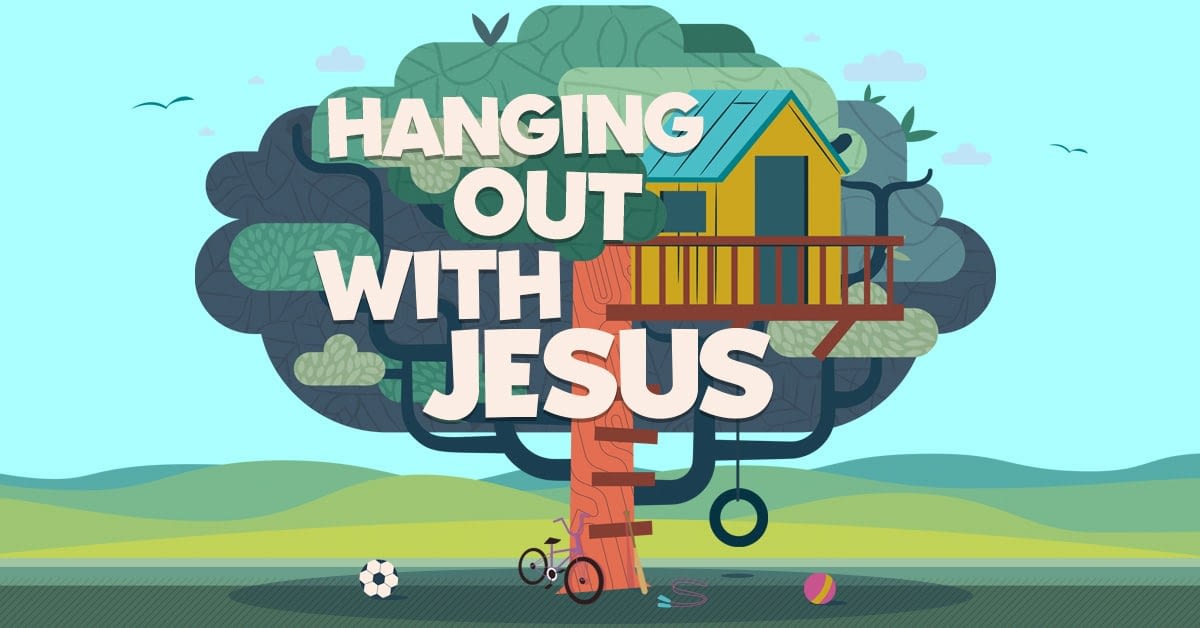Family support, biblical curriculum, and dedicated volunteers are all important to kids’ spiritual journeys. But memorable lessons balance sound teaching with exciting lessons, and children’s ministry games are a great way to keep learning fun!
Using games in your children’s ministry allows kids to move their bodies and have fun while also keeping kinesthetic learners engaged in the lesson.
That’s why we created this list of 20 children’s ministry games that are easy to host and get kids excited about learning! These games can be done in a variety of settings and use little to no props or prep. They can be used with specific lessons or tweaked to work in your context!

High Energy Children’s Ministry Games
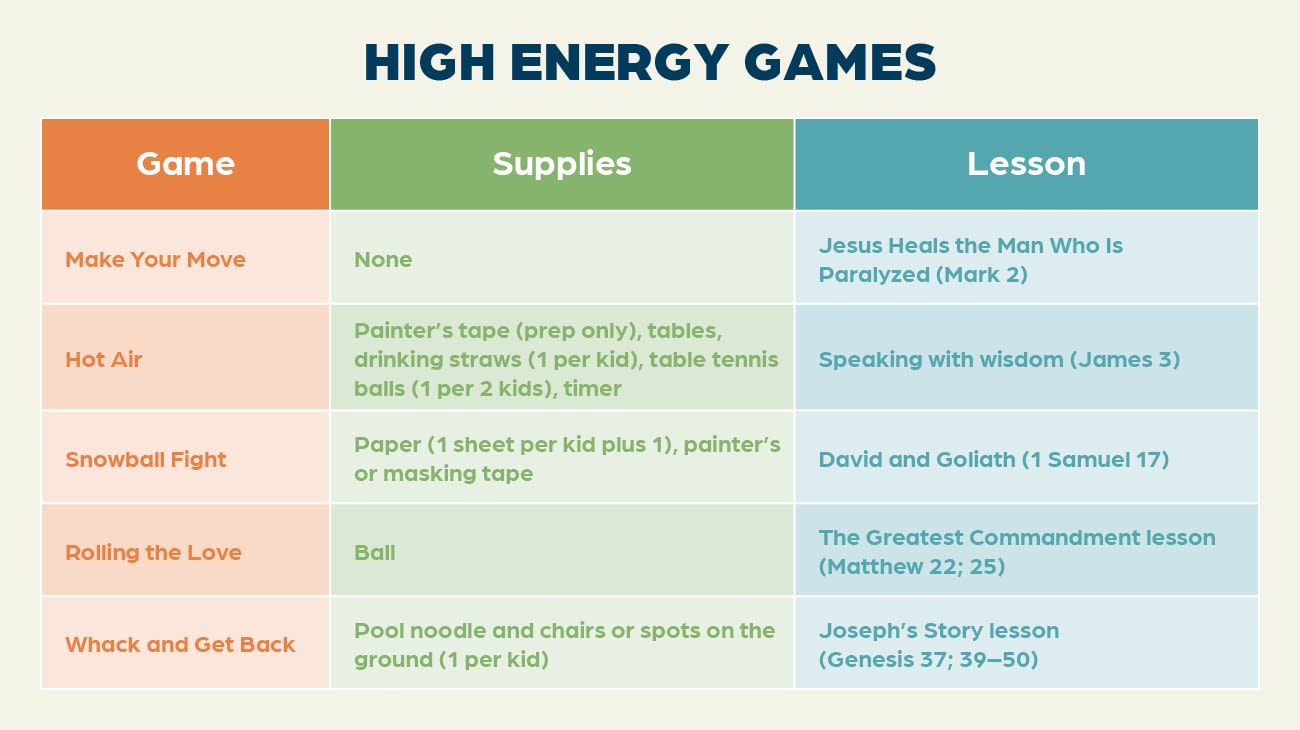
1. Make Your Move
This game works great with the Jesus Heals the Man Who Is Paralyzed lesson (Mark 2).
In this game, kids will leap to their feet in a variety of wacky, fun ways!
Invite kids to spread out around your room and sit on the floor. Explain that you’ll call out ways they are to leap up and move. Then, when you give the word, they’ll sit on the floor again until you call out another way to rise and move.
Ways to suggest they move can include the following: as kangaroos, sloths, superheroes, microwave popcorn, tap dancers, soccer (football) players, bowling balls, frogs, acrobats, snakes, eagles, hot air balloons, monkeys, tightrope walkers, or race cars.
When you’ve finished the game, invite kids to sit and catch their breath as you start teaching the lesson.
In the story, Jesus heals the paralyzed man. The man doesn’t just say he feels better. He gets up, rolls up his mat, and walks out of the room. He moves in a way he didn’t think possible! That’s because Jesus has the power to both forgive and heal the man. And Jesus still has the power to forgive and heal!
2. Hot Air
SUPPLIES: painter’s tape (prep only), tables, drinking straws (1 per kid), table tennis balls (1 per 2 kids), timer
This game works great with a lesson about speaking with wisdom (James 3).
In this game, kids will face off against their partners, each blowing through a straw to move their table tennis ball across a line on a table.
Ahead of time, set up tables. If you plan on having all the kids participate at once, you’ll need enough table space for every pair to stand across from their partners with 1–2 feet between them and the people next to them. Use painter’s tape to mark a line across the middle of each table. Alternatively, you can use fewer tables and have the kids take turns playing the game.
Gather the kids and help them form pairs. Explain that they will stand across the table from their partners with the tape line dividing the space between them. You will set a timer for 30 seconds, and during that time, they will blow through a straw towards a table tennis ball. Their goal is to move the ball across the line using only the wind coming through their straw. At the same time, their partners will also be blowing through straws and trying to get their balls to move in the opposite direction. Select a kid or adult volunteer to demonstrate how to play.
Invite pairs to find their places at tables, and give each kid a drinking straw. If there aren’t enough tables for everyone to play at one time, have pairs take turns playing. Hand a table tennis ball to each pair and instruct them to set the ball on the tape line when you say, “Go.” Start the 30-second timer and say, Go! Be available to chase after table tennis balls that fall off the table. Once all kids have had a chance to play, gather everyone together.
In the Bible story, we learn from the book of James how words impact us and others for good or for bad. When we use our words to hurt others, they are like the hot air coming through our straws toward our table tennis balls. James compares our tongues to a “fire,” for “a small spark can set a big forest on fire” (James 3:5–6). But God’s wisdom helps us use our words to bring peace and to build others up.
3. Snowball Fight
SUPPLIES: paper (1 sheet per kid plus 1), painter’s or masking tape
This game works great with the David and Goliath lesson (1 Samuel 17).
Before kids arrive, divide the room in half using painter’s or masking tape.
To organize kids into five groups, count them off from 1–5. Have them stand with other kids who were assigned the same number (1, 2, 3, 4, or 5).
Hand out blank sheets of paper and pencils to each kid. Encourage the kids to crumple their papers into “snowballs.”
Help kids form two teams, one on each side of the line of tape. When I say, “Go!” you’ll throw snowballs at the other team. And you’ll keep throwing snowballs until I say, “Stop!”
If your setting and group are loud, consider flipping the lights off and on one time as you call “Stop!” to get the kids’ attention. Just let them know ahead of time that you plan to do this, so it doesn’t take them by surprise.
When I call, “Stop!” you will gather up all the snowballs on your side and count them. The team with the fewest snowballs, wins. Ready? Set? Go!
After about two minutes, call, “Stop!” Encourage teams to work together to count their snowballs. Then gather kids together.
Have you ever had a real snowball fight? Let kids respond. In a snowball fight, how do you decide who wins? Let kids respond. Usually, it’s whoever stays the driest! So that means you were all victorious—just like we learned today that God always wins. In the Bible story, we see that God is always victorious!
4. Rolling the Love
SUPPLIES: foam dodgeball, timer
This game works great with The Greatest Commandment lesson (Matthew 22; 25).
In this game, kids will attempt to roll a ball through someone else’s legs. During the first round, kids will be out if the ball rolls through their legs. But during the second round, everyone will get to play the whole time!
Gather kids together and invite everyone to stand in a circle with their legs apart. Explain that the outside edge of each person’s feet should touch the outside edges of their neighbors’ feet. Demonstrate this stance for the kids.
If some kids in your group have limited mobility, make a circle out of chairs with the front legs of each chair touching the chair legs next to it. Then have kids play the game while seated in chairs rather than standing.
In this game, we will try to roll the ball through someone’s else’s legs. Demonstrate this by trying to roll the ball through the legs of someone else in the circle. For our first round, if the ball rolls through your legs, you are out. No one is allowed to block the ball but must stay in one spot as the ball rolls. The people who are out can stand outside the circle and cheer as the game continues. We will play for three minutes or until everyone except one person is out. Hand the ball to a willing kid to start the game by rolling the ball toward someone else and start a three-minute timer. Every time a someone gets out, the circle should tighten so that everyone’s feet are touching their neighbors’ feet. At the end of three minutes (or when there’s only one person remaining), congratulate the winner (or winners!) and invite everyone back to the circle.
We are going to play again, but this time if the ball rolls through your feet, that’s OK. You can just fetch the ball, return to your spot in the circle, and continue playing! Set the timer for three minutes and have kids play again, with everyone remaining in the circle the whole time.
What was the biggest difference between the first and second rounds of this game? Allow kids to share their thoughts. Yes, in the first round, you were out if the ball rolled through your legs, but in the second round, you got to keep playing no matter what! Today in God’s big story, we learned that love for God and love for others go hand in hand. However, sometimes we miss the mark and don’t love and care for the people the way Jesus does. Yet even when we miss the mark, God’s love is constant and never ends!
5. Whack and Get Back
SUPPLIES: pool noodle, chairs or spots on the ground (1 per kid)
This game works great with the Joseph’s Story lesson (Genesis 37; 39–50).
Direct kids to all sit in a circle in their chairs. There should be the same number of chairs as there is kids. Choose one kid to stand in the center of the circle with a chair. Place a pool noodle on the chair in the center of the circle.. The goal of this game is for the person in the middle to get to a seat in the circle before being tagged by the pool noodle. If you don’t have access to chairs, use a piece of paper or tape on the ground or have kids take their shoes off and set the shoes in front of them on the floor to signify their spot.
The person in the middle of the circle is “It.” She will pick up the pool noodle from the chair and use it to gently tag someone in the circle before putting the pool noodle back on the chair. Be careful not to hit anyone’s head with the pool noodle!
Then, the person who was tagged will run into the center of the circle and grab the pool noodle to try to tag the person who is “It.” If the person who is “It” can run to the empty seat before being tagged, then the person they tagged is now It! If the person who is “It” is tagged before sitting down in the empty chair, then he will remain “It” and try again.
If the pool noodle falls off the chair in the center of the circle, whoever put it on the chair before it fell off is automatically It. If this happens, a friend can volunteer to “save” the person in the middle by being “It” instead.
Play several rounds. After the game, have all the kids sit in their chairs.
God has a great and powerful arm, and He saves us! In the Bible story, God saved Joseph and the Israelites. In our game, you had an opportunity to save a friend by volunteering to be “It” for your friend. How does God save us and help us?
Children’s Ministry Games About Listening and Focus
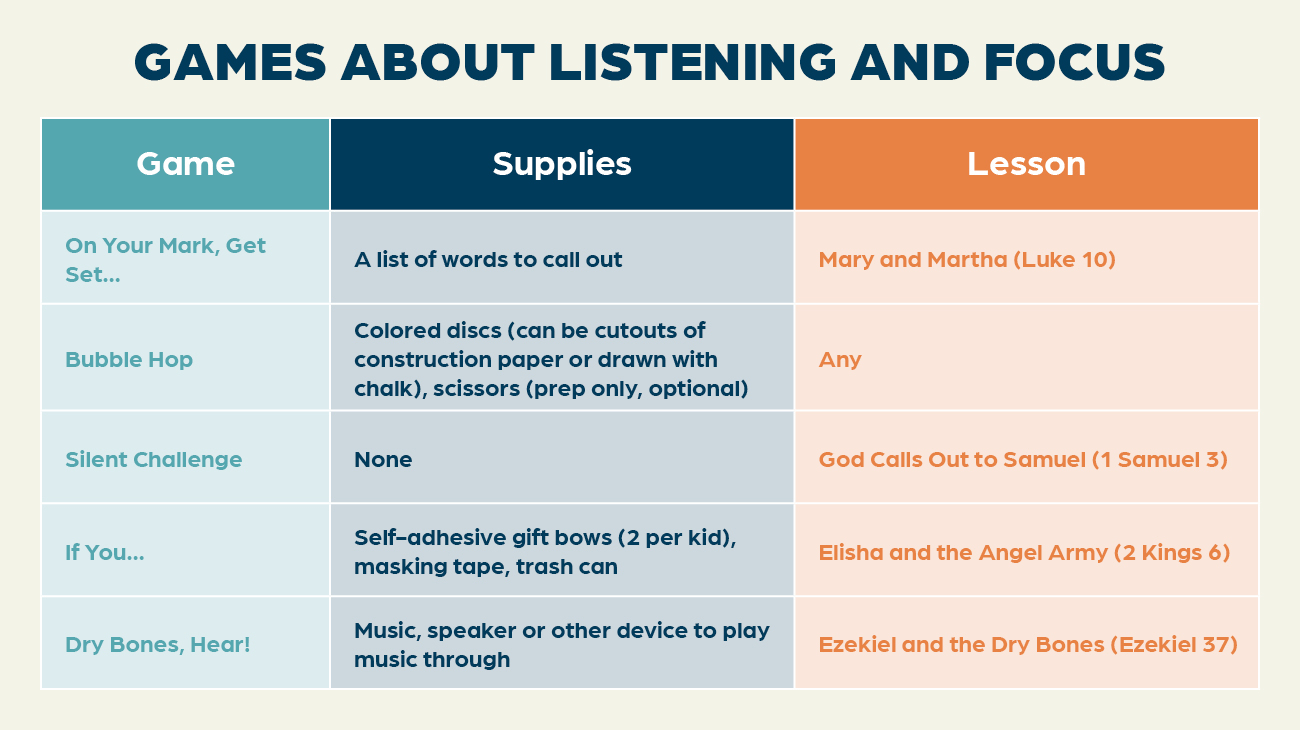
6. On Your Mark, Get Set …
This game works great with the Mary and Martha lesson (Luke 10).
In this game, kids will listen carefully to words shouted out by the leader and react when they hear the word “three.”
Ask kids to crouch down, and then explain the game: When they hear the word “three,” kids will jump up in the air and clap their hands before returning to the crouching position. You’ll call out “three,” but you’ll also call out words that sound as if they’ll turn into the word “three”… but don’t.
Any player who jumps up when you haven’t said “three” stays in the game but must run a lap of the room while on “twinkle toes,” like a ballerina dancing across the stage.
Urge kids to listen carefully and only to you, ignoring any chatter in the room that might distract them from hearing what you have to say.
If you listen carefully, you’ll be a bit like Mary, who listened so carefully to Jesus that she wasn’t distracted by all the work involved with hosting a houseful of people!
Words you might call out include the following: there, throw, think, threat, thimble, threw, threat, thighbone, throne, throttle, through, thick, thank, thumb, throat, trombone, thrift, thresh, thread, throttle, that, thrill, threaten, thriller, throng, thriving, throb, thaw, thistle, thrive.
7. Bubble Hop
SUPPLIES: colored discs (can be cutouts of construction paper or drawn with chalk), scissors (prep only, optional)
The objective of Bubble Hop is to be the first player to reach the finish line by hopping on bubbles while demonstrating patience and waiting for the right opportunity to move forward. This game works best in an open space—outdoors or a large indoor area. Designate a start line and a finish line and distribute “bubbles” throughout the space. The bubbles can be circles of construction paper or drawn with chalk. Be sure there are multiples of several different colors. (For example, six red bubbles, six green bubbles, six blue bubbles, etc.)
Invite kids to gather at the start line. We’re going to have a race called Bubble Hop. The first person to the finish line wins, but you can only move by hopping from one bubble to the next. These circles on the ground are the bubbles. Once the race begins, I’ll say a color, and then I’ll either say “Hop” or “Pop.” You’ll want to listen very carefully, because if I say “Hop” then you are allowed to hop to that color. If I say “Pop,” then that color is about to pop, and you need to get off it!
For example, if I say, “Green … hop!” then you may hop to a green bubble, if there’s one close enough to you. There may not always be a bubble you can reach. If I say, “Green … pop!” then the green bubbles are about to pop. If you are standing on a green bubble, then you need to hop to a different one!
If a kid hops to the wrong color or fails to hop away from a bubble that is about to pop, then he’s out. Sometimes there won’t be a bubble of the appropriate color near enough to reach. That’s OK! The point of this game is to help the kids practice patience—waiting attentively and listening carefully for the right moment to move. Note: No more than one kid may occupy the same bubble. The first kid to cross the finish line wins!
Do a quick practice round to make sure everyone understands before starting the real game.
Sometimes our faith feels like it’s mostly about things that happened a long time ago. Or it feels like our faith is mostly promises about things that will happen a long time from now—which means there’s a lot of watching and waiting. But Jesus wants us to have a relationship with Him right now! We can experience new life today.
8. Silent Challenge
This game works great with the God Calls Out to Samuel lesson (1 Samuel 3).
The goal of this game is for kids to try to communicate with one another in ways other than with voices. Encourage them to form a line in an order that you give them and without talking. They can use hand motions and facial expressions to communicate but can’t mumble or make any noises with their mouths. When they think they are done and in the correct order, the leader should go down the line, and they can talk as they give the answer to check their accuracy.
Younger kids may not know the order of the months; leaders can help if needed.
This game is easy. All that you have to do is to line up in order of whose birthday is first! We will start with January at this end and go down to December at the other end of the room! Sounds easy, right? The only catch is that you can’t talk or make any sounds with your mouth! You can only use your hands, body, and face to communicate. Then when you think you are in the right order, we will see how you did!
When the kids have completed the first round, you can have them line up according to other criteria: age, nearest home to church, number of pets, number of siblings, etc.
It was hard to get in order without being able to talk, wasn’t it? But you found other ways to communicate! We may not often hear God’s audible voice, but He still talks to us in other ways. But one person who heard God’s voice out loud was Samuel. How amazing it must have been to hear God’s voice loud and clear!
9. If You …
SUPPLIES: self-adhesive gift bows (2 per kid), masking tape, trash can
This game works great with the Elisha and the Angel Army lesson (2 Kings 6).
In this game, kids attempt to race from one side of the room to the other without the tagger grabbing a bow from their backs.
Give each kid two self-adhesive gift bows and have them stick the bows to their backs. (Encourage kids to help one another with this! Self-adhesive bows will stick better to some types of clothing than others, so have masking tape available for kids who need to increase the stickiness of their bows.) Have a trash can handy so kids can easily throw away the bow backings. Next, invite kids to line up along one end of the room. The goal for you who are lined up is to run across the room when called—but without the “tagger” in the center grabbing a bow from your back. Show kids where they will run. If you lose one bow, you’re still in. But when you lose both bows, you will join the tagger in the center and help grab other kids’ bows.
The tagger will either call out a color or an object, such as a food or animal. If he calls out a color and you are wearing that color, you will move to the other side of the room. If the tagger calls out an object that you like, such as a type of food, you will move to the other side of the room. Let’s do a couple practice rounds where I will act as the tagger.
If you’re wearing black, go! Let kids wearing black race across the room without losing any bows to you as you pretend to grab at their bows. Let’s do one more practice round. If you like pizza, go! Let kids who like pizza race across the room without losing any bows to you as you pretend to grab at their bows. Got it? Choose one outgoing kid to be the first tagger. The tagger does not need any bows on her back. Introduce the rest of the group to the tagger, and then have her stand in the center of the room. Eventually, there will be kids running both ways across the room, so encourage kids to be careful and watch where they are going. If your space is small or kids are particularly energetic, ask kids to speed walk rather than run.
When the final kid loses both bows, gather the kids together.
What happened as more kids joined the tagger? Allow kids to answer. Yes! The tagger group grew more powerful! Like Elisha’s servant in the Bible story, we can ask God to help us see His power. God can open our eyes to see His power more and more—and grow our trust in Him as He does!
10. Dry Bones, Hear!
This game works great with the Ezekiel and the Dry Bones lesson (Ezekiel 37).
In this modified version of musical chairs, kids pretend to be lifeless skeletons who only come to life when the music is playing.
Have you ever played Musical Chairs? This game is sort of like that, except there are no chairs. That’s because in this game you’ll pretend to be like the lifeless bones that came alive in Ezekiel 37!
Invite kids to spread out and lie down on the floor. When the music isn’t playing, they must lie completely still. When I say, “Dry bones, hear!” and start the music, then you come to life. Get up! Do a walk. Do a dance. Do whatever you want, just so long as you keep moving. When the music is playing, you have to keep moving. Then, when the music stops, drop to the floor and lie perfectly still. The last person to stop moving is out!
Play continues, eliminating one player per round, until there is only one kid left. She wins!
If there are kids in your group with physical restrictions, consider modifying the activity so that everyone may participate in the same way. For example, if you have a kid who is in a wheelchair, you might modify the activity by having all the kids sit in a chair when the music stops playing instead of lying on the floor.
God told Ezekiel to prophesy to the dry bones and say, “Hear the word of the LORD!” (Ezekiel 37:4). And they came to life. That’s the power of good news from God! God has good news for us, too.

Team-Based Children’s Ministry Games
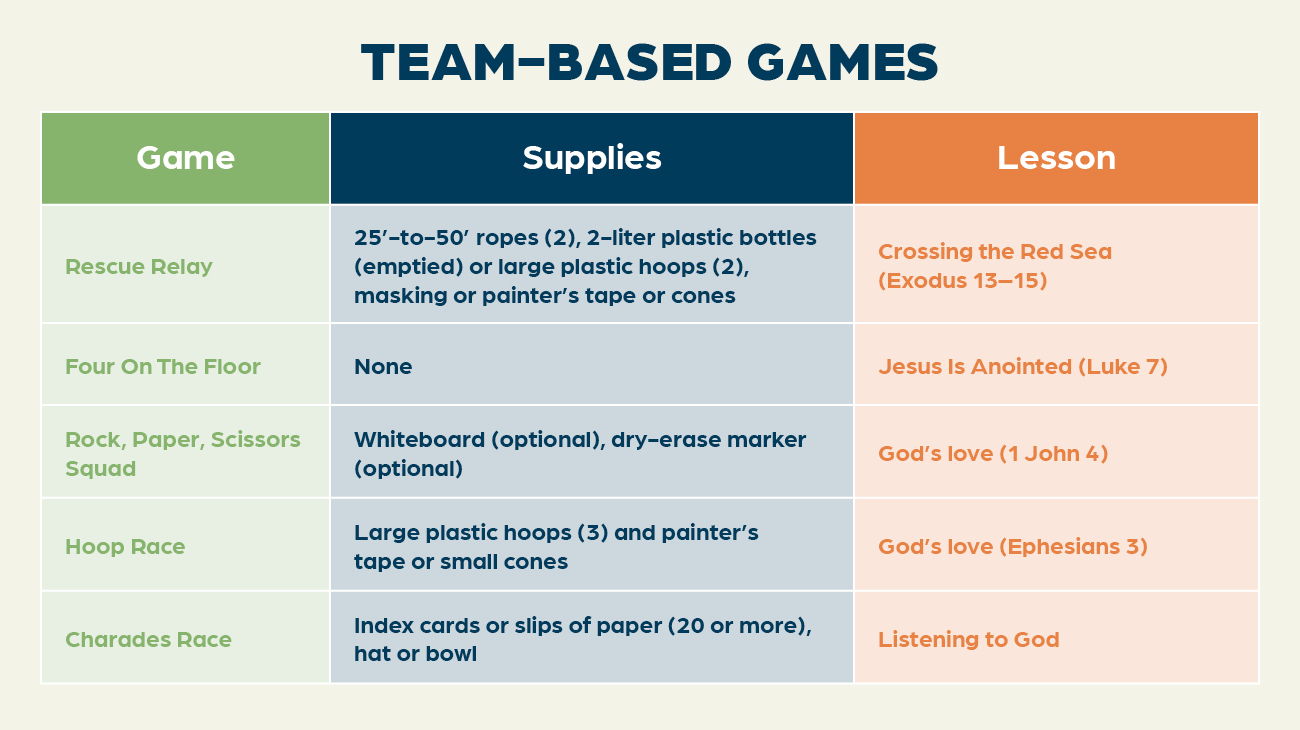
11. Rescue Relay
SUPPLIES: 25′-to-50′ ropes (2), empty 2 L plastic bottles or large plastic hoops (2), masking or painter’s tape or cones
This game works great with the Crossing the Red Sea lesson (Exodus 13–15).
Ahead of time, use masking or painter’s tape to create start and finish lines on the floor, or use cones to mark the start and finish lines.
Tie the end of a rope around an empty 2 L plastic bottle or a large plastic hoop. Repeat to create two sets. Set the bottles or hoops at one end of the room by the finish line. Stretch the rope across the room and place the other end at the start line.
In this game, kids will race to complete the rescue relay mission first.
Gather the kids and divide the group into two teams. In the Bible story, God rescues His people by providing a way through the Red Sea. We’re going to do a fun rescue relay mission of our own! When I say, “Go!” the first person will pull the rope until the bottle reaches the start line. Then she will grab the bottle, race across the room, place the bottle/hoop behind the finish line, and then run back to tag the next person in line. (The rope should still extend back to the start line.) The first team to have all of its members complete the rescue mission wins!
Once both teams have finished the rescue mission, congratulate the winning team and affirm all the kids for being excellent rescuers. Then gather kids and continue: We practiced our rescue skills, but God’s ability to rescue is much greater. God rescued His people from slavery and made the way for the people of Israel to escape through the Red Sea on dry ground! God is the ultimate rescuer!
12. Four on The Floor
This game works great with the Jesus Is Anointed lesson (Luke 7).
In this game, kids will pair up and partners will move back and forth across your room in creative ways.
Help kids form pairs and explain the game: You’ll call out a number between one and eight. Each pair will then cross the room with only that number of body parts in contact with the floor. The partners must be in contact with one another as they move. For instance, if you call out, “Four!” they can link arms as they walk across the room, or one partner can walk while holding the ankles of their partner whose hands are “walking” across the floor. Once pairs are across the room, call out a different number and see how pairs manage to move back across the room. Send kids back and forth until they are out of ideas, or you are out of time.
This game works best when kids are paired with someone of the same gender. If you don’t have an even number of girls and boys, invite one group of three to play. (Let them know that some numbers will be harder to pull off with three people!)
A time or two you probably had to help carry your partner as you crossed the room—and not only did that get heavy, it made it hard to move forward. When we have sin in our lives, it weighs us down too. And sin gets in the way of our moving forward in our friendship with God. But good news: Jesus forgives generously! When we confess and repent, the weight of our sin is lifted!
13. Rock, Paper, Scissors Squad
SUPPLIES: whiteboard (optional), dry-erase marker (optional)
This game works great a lesson about God’s love (1 John 4).
In this game, kids will play full-body Rock, Paper, Scissors, only instead of being eliminated when they lose, they will join the winner’s team, sharing in the ongoing fun of the game.
Gather kids together. You have probably played Rock, Paper, Scissors before, but you’ve probably never played it quite like we are about to! We’re going to play Rock, Paper, Scissors Squad, and there are two things that make this version of the game unique.
First, rather than make the rock, paper, and scissors motions with our hands, we’re going to use our whole bodies! Demonstrate each motion and have kids try each one:
- Rock: Crouch down into a ball, like a big rock.
- Paper: Stand up straight and with your hands pressed to your sides, like a flat piece of paper.
- Scissors: Stand with your feet shoulder length apart and arms extended above your head, make a “cutting” motion with your arms like a giant pair of scissors.
If kids in your group have limited mobility, you can play Rock, Paper, Scissors Squad using the customary hand motions for “rock,” “paper,” and “scissors” rather than the full-body actions.
Some kids, especially those who are younger, might be new to Rock, Paper, Scissors. So, briefly explain how each motion defeats another: Rock beats Scissors, Paper beats Rock, Scissors beats Paper. Consider writing this on a whiteboard to help kids remember.
Second, if you lose in Rock, Paper, Scissors Squad, you’re not out! Instead, you will join the winner’s team—or squad. When you join someone else’s team and face off against another opponent, you will talk quietly amongst yourselves to decide which motion to do next before the face off begins. Eventually, small teams will join up together until everyone is on one large squad!
Call up a kid or adult volunteer to join you in demonstrating the game. Count down from three and do your rock, paper, or scissor full-body motion. Explain to kids that if you show the same motion, it’s a tie, and you can go again. Then invite kids to stand up, find a neighbor to pair up with, and begin! Circulate among the kids as they play, helping them as needed. Play until everyone is on one large squad. Then gather kids together.
As the game went on, your squads became larger and larger as more and more people got to share together in the fun! In the Bible story, we lean that love comes from God, and we get to share it with others!
14. Hoop Race
SUPPLIES: large plastic hoops (3), painter’s tape or small cones
This game works great with a lesson about God’s love (Ephesians 3).
Ahead of time, use painter’s tap or cones to create a start line and finish line on the floor.
In this game, teams will race each other while jumping through large plastic hoops much like they would jump ropes.
Gather kids together and help them form three equal-sized teams. (If your group and space is large, consider having more than three teams with a large plastic hoop for each.) Alternatively, if time or space is limited, select three kid volunteers to race while everyone else cheers for them.
For this game, teams will race from the start line to the finish line. When it’s your turn, you will swing your team’s hoop over your head like a jump rope and jump through it. If you are able, demonstrate this for the kids. Or invite another leader or an older kid to demonstrate each step. Then you will toss the hoop in front of you, jump into it, pick it back up, and swing it over your head again like a jump rope. You’ll continue doing this until you reach the finish line. Once you’ve crossed the finish line, you’ll run with the hoop back to your team and hand it to the next person in line. The goal is for everyone on your team to make it to the finish line.
Once all the teams are set, begin: Ready, set, go! Cheer for kids by name as they race and be ready to help any who need extra assistance. When everyone has finished, gather kids together.
Everyone did an amazing job! To get through the hoop, you had to jump pretty high. And to get across the room, you had to go a long way. But you did it, and you didn’t stop! This game can remind us of what Paul wrote about God’s love, saying, “May you know how wide and long and high and deep it is” (Ephesians 3:18). Always and no matter what, God’s love for you will never end.
Wonder Ink’s 3-year, 52-week children’s ministry curriculum offers kids space to fully find their place in God’s Big Story. Children discover they are Known by God, Loved by Jesus, and Led by the Holy Spirit.
15. Charades Race
SUPPLIES: index cards or slips of paper (20 or more), hat or bowl
This game works great with a lesson about listening to God.
Before kids arrive, write the following words on index cards or slips of paper: dog, airplane, train, banana, elephant, bike, boat, baseball bat, swing, toilet, brushing teeth, eating a hot dog, climbing a ladder, butterfly, diving off a diving board, tent, monkey, flipping burgers, birthday cake, roasting a marshmallow, and any other words or actions you want to add. You will need one per kid. Place the cards or pieces of paper in the hat or bowl.
Divide your group into two equal teams, one at each end of the room. Choose someone from each team to go first. Ask a leader to hold the hat or bowl on the opposite end of the room.
For this game, the first person from each team will race to the person holding the hat or bowl, pull a card, and then race back to the team. The actor will try to get the team to guess the words on the card without talking, mumbling, or making any sounds. When the team guesses correctly, the next person can race down to get a new card to act out. You will do that until each person on the team has had a turn to act. The first team to guess correctly for every person wins the game!
Once one team has finished, give the other team a chance to act out their words for the whole group.
When the game is finished, gather the teams together. It was hard to communicate without talking, especially since you had to run to get the card and think fast while running. God can communicate to us in many ways. He may not talk in a voice we can hear, but we can still listen for Him and hear from Him through His word.
Children’s Ministry Games Requiring Little (Or No) Preparation
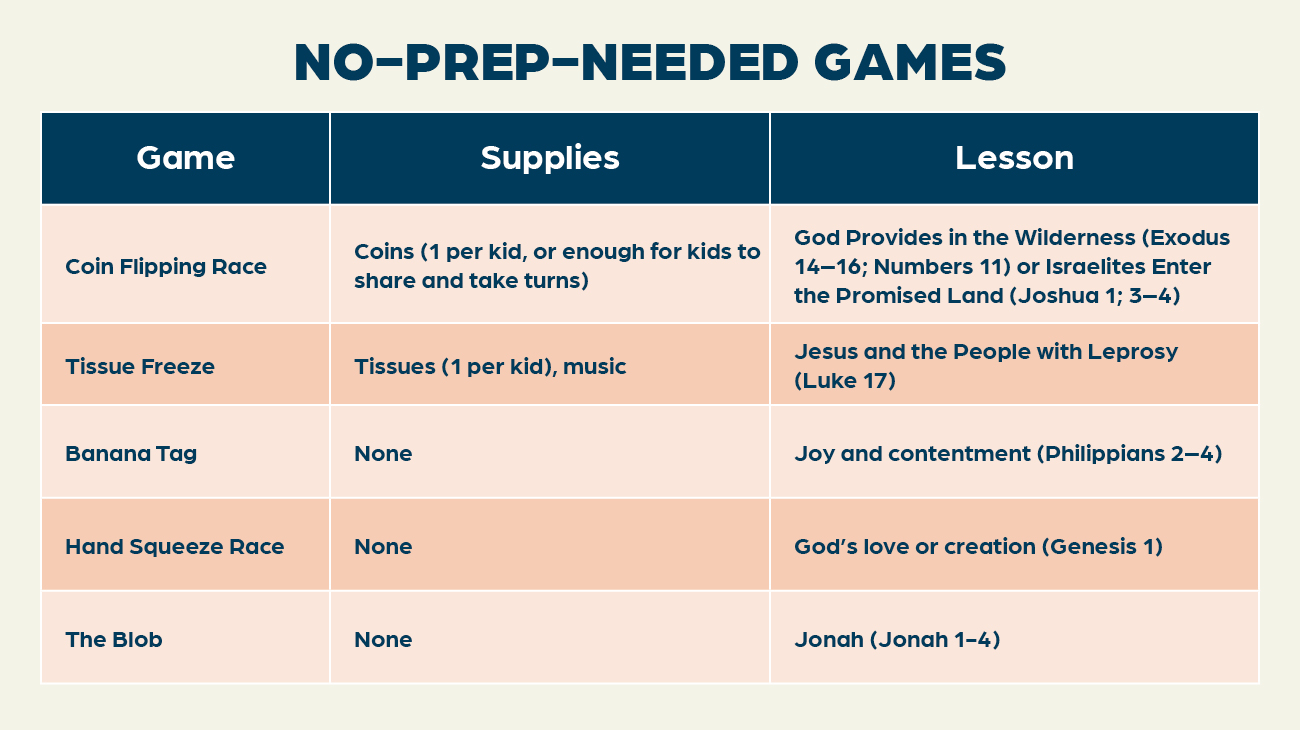
16. Coin Flipping Race
SUPPLIES: coins (1 per kid, or enough for kids to share and take turns)
This game works great with the God Provides in the Wilderness (Exodus 14–16; Numbers 11) or Israelites Enter the Promised Land lesson (Joshua 1; 3–4).
Each kid will get a coin (any kind of coin will work, even fake coins!). The kids will line up in a row on one end of the room with their coins. If you don’t have enough coins or space for all the kids to play at once, you can let the kids play in groups.
Who knows how to flip a coin? Sometimes in sports games, teams flip a coin to see who goes first. We’re going to play a game involving flipping a coin. You all have a coin. Do you know which side is “heads” and which side is “tails”? Show the kids which side is which, or if the coins don’t have distinguishable “heads” and “tails,” designate one side as “heads” and the other as “tails.”
When I tell you to start, you’re going to race to the other side of the room! But you can’t just run like a normal race! You’re all going to flip your coin onto the ground in front of you all at the same time. You need to keep track of your coin, so let’s all spread out as much as we can. If your coin lands on “heads” you can take one step forward. If it lands on “tails,” keep flipping it until you see it land on “heads.” Demonstrate how to flip a coin and let the kids practice a few times.
For younger kids who have trouble flipping a coin, give them a small cup and have them put their coin inside. They can cover the top of the cup with their hand and then shake the cup to flip the coin.
The first person to get to the other side of the room (they can either cross a finish line if you have a way to mark it, or touch the wall) wins!
Once the entire group has made it to the other side, if you want to keep the game going, you can have them go back but this time, have them hop or skip instead of just taking one step each time.
You couldn’t move until your coin landed on heads, so your coin was leading you to the finish line. Kind of like how your coin led you, in the Bible story, God led the Israelites in the wilderness. He told them when to go forward and when to stop, like your coin told you when to move forward or stop.
17. Tissue Freeze
SUPPLIES: tissues (1 per kid), music
This game works well with the Jesus and the People with Leprosy lesson (Luke 17).
Today’s game is called Tissue Freeze. Each of you will stand up and place a tissue on your head. As the music plays, you will walk around the room. If the tissue falls off your head, you become frozen and are out of the game. The only way to be unfrozen is for someone who is still in the game to come and put the tissue back on your head. Then you are unfrozen and may rejoin the game.
Give everyone a tissue and have them place it on their head. Start the music. Play this game as long as time allows.
This was a simple game, but it required someone to help you if you became frozen. You needed another person to put the tissue back on your head so you could rejoin the game. that Jesus cares for everyone. One way He shows He cares is by helping us when we need help.
18. Banana Tag
This game works great with a lesson on joy and contentment (Philippians 2–4).
This is a twist on a basic freeze tag game. When kids are tagged, they have to stand with their bodies in the shape of a banana and can only be unfrozen when another kid peels them.
Choose one or two kids to be “It,” or the tagger(s). If the tagger touches you, you must freeze and stand like a banana. Demonstrate a stance with your arms together in a sideways arch over your head, curving your body into a “C” shape as you are able. You will be frozen like this until someone else comes and peels you. Have another leader demonstrate pulling your arms down by your side, one at a time. Then, you will be free to run and move again!
Give kids a few seconds head start before letting the tagger(s) go. When the tagger seems tired, feel free to switch to a new tagger and let the group know. When the kids are tired from running or time is up, call them together. You all looked pretty silly pretending to be bananas! Bananas are a great fruit that I enjoy eating. Do any of you like to eat bananas? Pause to give kids a chance to raise their hands. Another kind of fruit that isn’t something we eat is joy. In the Bible, Paul says we should constantly be full of joy. Watching you all pretend to be bananas and peel each other sure brought joy today!
19. Hand Squeeze Race
This game works great with a lesson about God’s love or creation (Genesis 1).
How many of you here have a strong arm? We are going to test that today in our game! We are going to pass a hand squeeze down a line.
Divide the group into two equal teams and have kids stand or sit in a line and hold hands. Stand at one end and say, “Go!” Each team will start a hand squeeze with the first person in each line. When each kid feels a hand squeeze, that kid will pass the hand squeeze on to the next kid in line. Make sure the kids know not to squeeze the next person’s hand until their hand has been squeezed.
When the squeeze gets to the end of the line, the kid at the end will run to the opposite side of the room, hit the wall, and then run back to the line. You can end the game here and start a new round, or keep the game going and have the person who tagged the wall move to the front of the line (all of the kids will have to scoot a little to make room). The person who is the new head of the line will start another hand squeeze, and the game will continue until every kid on the team has tagged the wall.
The goal of this game is to move the hand squeeze through the line the fastest! We will split into two equal groups, and each group will form its own line. Once the hand squeeze gets to the end of the line, the person at the end will run and hit the wall at the other side of the room. Whatever team hits the wall first wins!
You can’t pass on the squeeze to the person beside you until you feel a hand squeeze. Also, don’t squeeze so hard that you hurt the person you’re holding hands with. As soon as the last person in each line feels a squeeze, he will run and hit the wall way over there and then run back to the beginning of the line.
If it becomes obvious that someone messes up and passes a squeeze too soon, the team can start at the beginning of the line again or take a three second penalty before the last kid runs to touch the wall.
You were right—so many of you are strong! Isn’t it great to know we also have a strong God who is all powerful? As strong as your arms are in this game, God’s arm is so strong that He made and cares for the whole world!
For younger kids, or a room without a lot of space to run, play the game with a small ball at the end of each line and tell the last person in line to grab the ball as soon as the squeeze makes it to the end of the line.
20. The Blob
This game works great with the Jonah lesson (Jonah 1–4).
In this modified version of Tag, every time a kid gets tagged, he gets incorporated into the Blob. The Blob grows and grows until all the kids are a part of it.
To start, we need someone to be Baby Blob. Allow one of the kids to volunteer or pick one to start the game. Baby Blob is trying to get you. If Baby Blob tags you, then you become a part of the Blob. You must hold onto one of Baby Blob’s arms, and then the two of you continue hunting for others to get.
Before this game begins, offer some guidelines for appropriate touch: tags should be gentle, on the arm, shoulder, or upper back. When someone gets tagged and must join the Blob, they should hold onto someone’s arm, preferably between the elbow and the wrist.
As each new person is tagged, they too join the Blob by holding onto the arm of someone who is already a part of it. As the Blob grows, it will include more and more kids, but each will only be able to tag with one of her hands because she’ll be using the other to hold onto the Blob.
Those of you who have not been caught by the Blob, your job is to stay away! But here’s the catch: you have to crawl on your hands and knees. Alternatively, you can have students hop on one foot, crab walk, or do something similar. Adjust the difficulty as needed, depending on the age of your kids. Just be sure the kids who are trying to stay out of the Blob have their movement restricted in some way, because as the Blob grows, it’ll become slower (and more hilarious) while catching the last remaining kids.
If you have kids with physical restrictions, a great way for them to participate is to serve as an Assistant Referee. Position them on the opposite side of the play area from yourself and ask them to help determine whether someone got tagged or not.
In the Bible story, when Jonah tried to run away from God, he was swallowed by a huge fish. God has good news for the whole world, but Jonah did not want to bring God’s message to the people of Nineveh. In the end, Jonah went to Nineveh and shared the good news. God has good news for the whole world—including us!
More Fun from Wonder Ink
- Simple, Fun Ideas to Engage Families in Summer
- 4 Things to Do When Teaching Kids to Pray
- How Spiritual Practices for Kids Can Help Them Know God
- Known, Loved, and Led: Helping Children Know Who They Were Created to Be
- 26 Free Preschool Coloring Pages for Your Children’s Ministry
Plus, check out these free lessons from Ministry Spark!





